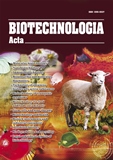ISSN 2410-7751 (Print)
ISSN 2410-776X (Online)

Biotechnologia Acta Т. 16, No. 6 , 2023
P. 82-87, Bibliography 16, Engl.
UDC:: 582.282.195.2:579.222
DOI: https://doi.org/10.15407/biotech16.06.082
Full text: (PDF, in English)
Kholodny Institute of Botany of the National Academy of Sciences of Ukraine, Kyiv, Ukraine
Purpose. This study was conducted to enhance comprehension of the dynamic process synthesis of phenolic compounds by representatives of the genus Xylaria and the correlation between phenol content and antioxidant properties found in biomass and culture liquid during submerged cultivation.
Methods. Cultivation of Xylaria polymorpha and Xylaria longipes fungal strains from the IBK Mushroom Culture Collection was carried out on a glucose-yeast-peptone nutrient medium under submerged conditions. Harvesting of biomass and culture liquid was done on the 3rd, 5th, 7th, and 9th day of cultivation, followed by extraction with ethyl acetate. The total phenol content of extracts was determined using the Folin–Ciocalteu method. The antioxidant potential was evaluated through the DPPH assay.
Results. Findings revealed that the accumulation of phenolic compounds by fungal species of the Xylaria genus was specified on a strain level. Notably, X. longipes strains exhibited higher production of phenolic constituents compared to X. polymorpha and demonstrated superior antioxidant activity. Furthermore, a strong correlation was established between the dynamics of polyphenol accumulation and antioxidant activity in both mycelial biomass and culture liquid.
Conclusions. Natural phenolic compounds with antioxidant properties were extracted from the biomass and culture liquid of the studied strains. Significantly higher concentrations of phenolic compounds and values of antioxidant activity were found in the biomass compared to the culture liquid. The results indicated that a later day of cultivation was not necessarily equivalent to the production of more phenols, emphasizing the need for a comprehensive assessment of these compounds' accumulation and the dynamic study of the related parameters.
Key words: Xylaria, phenolic compounds, antioxidants, dynamics, biomass, culture liquid.
References
- Macías-Rubalcava, M. L., Sánchez-Fernández, R. E. Secondary metabolites of endophytic Xylaria species with potential applications in medicine and agriculture. World Journal of Microbiology and Biotechnology. 2017, 33, 1¾ https://doi.org/10.1007/s11274-016-2174-5
- Song, F., Wu, S.–H., Zhai, Y.–Z., Xuan, Q.–C., & Wang, T. ChemInform abstract: secondary metabolites from the genus Xylaria and their bioactivities. ChemInform. 2014, 45(30), 673–694. https://doi.org/10.1002/chin.201430235
- Schneider, G., Anke, H., Sterner, O. Xylaramide, a new antifungal compound, and other secondary metabolites from Xylaria longipes. Zeitschrift Für Naturforschung C. 1996, 51(11¾12), 802-806. https://doi.org/10.1515/znc-1996-11-1206
- Deyrup S., Gloer J., O'Donnell K., Wicklow D. Kolokosides A−D: Triterpenoid Glycosides from a Hawaiian Isolate of Xylaria sp. Journal of natural products. 2007, 70, 378¾ https://doi.org/10.1021/np060546k
- Jang YW., Lee IK., Kim YS, Lee S., Lee HJ., Yun BS. Xylarinic Acids A and B, New Antifungal Polypropionates from the Fruiting Body of Xylaria polymorpha. J Antibiot. 2007, 60, 696–699 https://doi.org/10.1038/ja.2007.89
- Wu W, Dai H, Bao L, Ren B, Lu J, Luo Y, Guo L, Zhang L, Liu H. Isolation and structural elucidation of proline-containing cyclopentapeptides from an endolichenic Xylaria sp. J Nat Prod. 2011,74(5),1303¾ https://doi.org/10.1021/np100909y
- Yin X., Feng T., Li ZH,Su J., Li Y., Tan NH., Liu JK. Chemical investigation on the cultures of the fungus Xylaria carpophila. Nat. Prod. Bioprospect. 2011, 1, 75–80. https://doi.org/10.1007/s13659-011-0011-y
- Mathew S., Abraham T. E., Zakaria Z. A. Reactivity of phenolic compounds towards free radicals under in vitro conditions. Journal of Food Science and Technology. 2015, 52(9), 5790–5798. https://doi.org/10.1007/s13197–014–1704–0
- Berikashvili V., Khardziani T., Kobakhidze A., Kulp M., Kuhtinskaja M., Lukk T., Gargano M. L., Venturella G., Kachlishvili E., Metreveli E., Elisashvili V. I., Asatiani M. Antifungal Activity of Medicinal Mushrooms and Optimization of Submerged Culture Conditions for Schizophyllum commune (Agaricomycetes). International Journal of Medicinal Mushrooms. 2023, 25(10), 1–21. https://doi.org/10.1615/intjmedmushrooms.2023049836
- Bisko N., Mustafin K., Al-Maali G., Suleimenova Z., Lomberg M., Narmuratova Z., Mykchaylova O., Mytropolska N., Zhakipbekova A. Effects of cultivation parameters on intracellular polysaccharide production in submerged culture of the edible medicinal mushroom Lentinula edodes. Czech Mycology. 2020, 72(1), 1–17. https://doi.org/10.33585/cmy.72101
- Atamanchuk A. R.; Bisko N. A. Cultural and morphological characteristics of wood–inhabiting Xylaria species from Ukraine. Plant & Fungal Research. 2022, 5(2), 11–19. https://doi.org/10.30546/2664
- J., Deng G.–F., Xu X.–R., Wu S., Li, S., Xia E.–Q., Li F., Chen F., Ling W.–H., Li H.–B. Antioxidant capacities, phenolic compounds and polysaccharide contents of 49 edible macro–fungi. Food & Function. 2012, 3(11), 1195–1205. https://doi.org/10.1039/c2fo30110e
- Liu X., Dong M., Chen X., Jiang M., Lv X., Yan G. Antioxidant activity and phenolics of an endophytic Xylaria sp. from Ginkgo biloba. Food Chemistry. 2007, 105(2), 548–554. https://doi.org/10.1016/j.foodchem.2007.04.008
- Elfahri K. R., Vasiljevic T., Yeager T., Donkor O. N. Anti–colon cancer and antioxidant activities of bovine skim milk fermented by selected Lactobacillus helveticus strains. Journal of Dairy Science. 2016, 99(1), 31–40. https://doi.org/10.3168/jds.2015–10160
- Cheung L. M., Cheung P. C. K., Ooi V. E. C. Antioxidant activity and total phenolics of edible mushroom extracts. Food Chemistry. 2003, 81(2), 249–255. https://doi.org/10.1016/s0308-8146(02)00419-3
- .Bhanja Dey T., Chakraborty S., Jain K. Kr., Sharma A., Kuhad R. C. Antioxidant phenolics and their microbial production by submerged and solid state fermentation process: A review. Trends in Food Science & Technology. 2016, 53, 60–74. https://doi.org/10.1016/j.tifs.2016.04.007)
© Palladin Institute of Biochemistry of National Academy of Sciences of Ukraine, 2023

